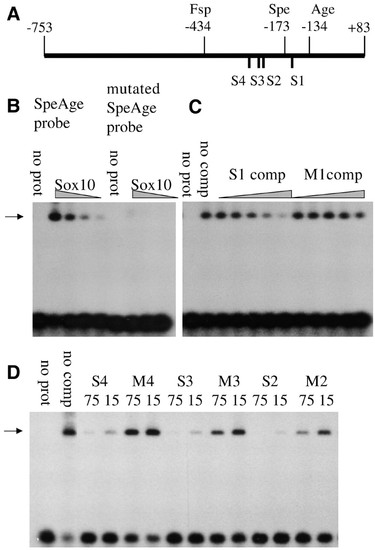Fig. 4
- ID
- ZDB-FIG-101004-20
- Publication
- Elworthy et al., 2003 - Transcriptional regulation of mitfa accounts for the sox10 requirement in zebrafish melanophore development
- Other Figures
- All Figure Page
- Back to All Figure Page
|
Electrophoretic mobility shift assays (EMSA) showing binding of Cls/Sox10-GST fusion protein to sites in the nac/mitfa promoter. (A) Schematic diagram of the 836 b.p. nac/mitfa promoter showing the positions of the putative sox binding sites S1, S2, S3 and S4. (B) The Spe1-Age1 fragment of the nac/mitfa promoter (SpeAge probe) shows a band of reduced electrophoretic mobility (black arrow) with ∼20 nM, 10 nM, 5 nM and 2.5 nM Cls/Sox10-GST fusion protein (Sox10) which is not seen without the Cls/Sox10-GST protein (no prot). When site S1 is mutated in this DNA fragment (mutated SpeAge probe) binding under these same Cls/Sox10-GST protein concentrations is greatly reduced. (C) Binding of∼ 10 nM Cls/Sox10-GST protein to the Spe1-Age1 fragment of the nac/mitfa promoter is effectively competed by an oligonucleotide with site S1 (S1 comp) but not by the mutated site oligonucleotide M1 (M1 comp). Shown are binding reactions with a serial five-fold dilution series of this competitor oligonucleotide giving 0.13 to 75 pmoles per reaction and also controls with no specific competitor (no comp) and with no Cls/Sox10-GST protein (no prot). (D) Binding of ∼10 nM Cls/Sox10-GST protein to the Spe1-Age1 fragment of the nac/mitfa promoter is effectively competed by oligonucleotides with binding sites S2, S3 or S4 but less effectively by the mutated versions M2, M3 or M4. Shown are binding reactions with 75 pmoles (75) or 15 pmoles (15) of these competitor oligonucleotides and also controls with no specific competitor (no comp) and with no Cls/Sox10-GST protein (no prot). |

